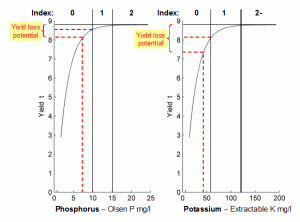Download pdf: Calculator for estimating nutrients needed to correct soil deficiency (373.54K)
pdf 373.54K
Calculator for estimating nutrients needed to correct soil deficiency
October 2012

In the previous Newsletter it was noted that in many cases it could take between 10 and 20 years to change the nutrient status of a soil from Index 1 to 2 if only the additional 30 kg/ha as suggested in the Fertiliser Manual (RB209) is added to the crop offtake when making a phosphate or potash recommendation for deficient soils. It cannot be considered economic (or environmental) good practice to tolerate a nutrient deficiency over such a long period and a new PDA Calculator provides an alternative approach. Yield relationship curves for phosphate and potash were published recently in the HGCA Report 485 (see Figure 1).
Compared with a soil at the standard target Indices, these show potential wheat yield reductions of 0.75 t/ha for soils in the upper half of P Index 0 and of 1.3 t/ha for soils in the upper half of K Index 0. At a grain price of £175/tonne these yield reductions could cost £131/ha and £227/ha respectively (Table 1).
Table 1: Potential financial implications for an 8.8 t wheat crop on nutrient deficient soils.
| Bottom of Index 1 | Top half of Index 0 | |||
| Yield reduction vs. soil at Index 2 |
Income lost per year, wheat grain @ £175/t |
Yield reduction vs. soil at Index 2 |
Income lost per year, wheat grain @ £175/t |
|
| Phosphorus | 0.25 t/ha | £44/ha | 0.75 t/ha | £131/ha |
| Potassium | 0.7 t/ha | £131/ha | 1.3 t/ha | £227/ha |
It is clear from Table 1 (which is derived from Figure 1) that there is a considerable potential yield and income loss on soils with below optimal or target Index. In order to help farmers and growers to correct soil nutrient deficiencies more quickly, and so lessen the time over which a field is at risk of significant yield loss, a Calculator has been developed which will provide an indication of the nutrients required for correction, and the annual applications needed over a chosen number of years.
The PDA Phosphate and Potash deficiency correction and offtake Calculator is designed to run on a computer and also independently on mobile units such as an iPhone, iPad or Android device. The Calculator has two main functions.
- It enables a quick calculation of the phosphate (P2O5) and potash (K2O) offtakes by most UK crops at harvest.
- If soil Indices are below the target level the second section of the Calculator provides a guide to the quantity of nutrient which is likely to be required to correct the deficiency. This will vary according to the level of deficiency and the soil type. The quantity will usually be more than can reasonably be applied in one season, and the Calculator asks by how much and how quickly you want to correct the deficiency, i.e. over how many years. The desired improvement can be input by Index or more precisely by mg/litre as determined by soil analysis.

The Calculator displays the nutrients required to replace the offtake at harvest, and shows separately the guide quantity of phosphate and or potash needed to correct the deficiency. This separate display of the two components of the fertiliser recommendation is important because the crop should pay for the nutrients removed at harvest, but not for the correction of the deficiency. This fertiliser should be charged to a separate account, as would be the case for liming and drainage costs.
It is important to read the notes attached to the Calculator. Large single applications of phosphate must be made with care to avoid losses to watercourses through surface run-off or via cracking clay soils. It is recommended that deficiency-correcting applications of phosphate should not usually exceed 100 kg P2O5/ha per year. Phosphate and potash applications made to correct deficiencies should be incorporated fully into the topsoil. Potash should always be applied with care to avoid high concentrations close to seeds or seedlings. Ideally a major portion of corrective dressings of potash should be ploughed down. The Calculator gives guide results only; the effects of applications of fertilisers or manures must be checked by regular soil analysis. The Calculator cannot be used to indicate timescales for any reductions in Indices higher than target.

